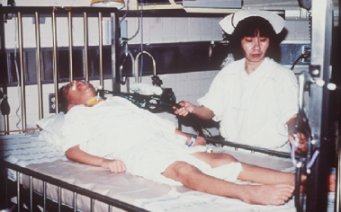
 Product Name: Japanese Encephalitis Vaccine
Product Name: Japanese Encephalitis VaccineCommercial Name: JE-Vax Date of Licensure: 10 December 1992 Type of Product: : formalin-inactivated whole virus vaccine Company of Manufacture: The Research Foundation for Microbial Diseases of Osaka University (BIKEN), currently distributed in the United States by Sanofi-Aventis Target microorganism/associated disease: Japanese encephalitis virus (JEV; previously called Japanese encephalitis type B) is a flavirvirus transmitted by mosquitoes that is associated with outbreaks of encephalitis (brain inflammation) in Asia, the Pacific Islands, northern Australia and Russia. JEV transmission is generally seasonal and limited to rural areas (pigs and birds are important for viral maintenance, amplification and spread). Within Asia, JE is the most important cause of human encephalitis, and causes approximately 35,000 cases and 10,000 deaths annually. Although between 25 and 1,000 asymptomatic JEV infections occur for each identified clinical case of JEV, and symptoms may be limited to mild illness with fever in some persons, the case-fatality rate for persons with evident disease is about 25%, and at least 50% of JE survivors have sequelae ranging from mood changes to severe neurological impairment. Reasons for development: The first Japanese encephalitis vaccine utilized by U.S. forces was developed during WWII to protect U.S. troops deployed to Asia and the Pacific. Outbreaks of Japanese encephalitis (JE) occurred among U.S. troops in Okinawa in 1945. A need for a more efficacious vaccine became apparent during U.S. involvement in the Korean War, when there were 299 cases of proven or suspected JE among US forces despite administration of JE vaccine to all U.S. troops in the Far East Command between 1946 and 1951 (at which point the U.S. army ceased JE vaccine administration). Currently, there is no effective treatment of JE beyond supportive care, and use of pesticides results in minor reductions of JEV vectors in a limited area for a short period of time at considerable cost. Role of Department of Defense in product development: JEV was first isolated in 1935 from the brain of a patient dying of encephalitis in Japan. At the beginning of World War II, anticipating possible epidemics among U.S. forces in the Pacific, the Commission on Neurotropic Virus Diseases of the Army Epidemiology Board assigned MAJ. Albert Sabin the task of developing a vaccine against JE and to stockpile vaccine to be used in the event of outbreaks. A crude vaccine derived from formalin-inactivated brains of mice infected with JEV was developed (based on the earlier work of Japanese and Russian scientists) and administered to approximately 250,000 military personnel during World War II, beginning shortly after the outbreak in Okinawa. In addition, Sabin and others recorded clinical descriptions of laboratory-confirmed cases, and performed studies to identify the natural vectors and reservoirs. The ecology of JEV was elucidated in greater detail by DoD investigators Buescher and Scherer working in Japan in the late 1950's. Increased demand for a JEV vaccine for U.S. citizens began in 1981, when a 20-year-old student from Washington, D.C. contracted fatal Japanese encephalitis at Beijing University. Japanese encephalitis vaccine trials were conducted by the U.S. Centers for Disease Control (CDC) beginning in 1983, when CDC began distributing the vaccine in the U.S. under an Investigational New Drug application until 1987. In the mid-1980's, DoD lead by Charles Hoke with collaborators in the Thai Ministry of Public Health led the definitive study evaluating 2 doses (given 1 week apart) of the highly purified BIKEN vaccine (Nakayama-Yoken strain) versus a bivalent vaccine (NakayamaYoken and Beijing-1 strains) versus placebo (tetanus toxoid). There were approximately 22,000 Thai schoolchildren in each of these recipient groups. The efficacy of both monovalent and bivalent vaccines was 91 percent, achieved with minor vaccine adverse effects (headache, sore arm, rash, and swelling). However, an initial 3-dose regimen (plus booster doses) is recommended by the CDC for optimal immune response. |
| Influenza | Rubella Vaccine | Adenovirus | Meningococcal | Hepatitus B | Oral Typhoid | Japanese encephalitis | Hepatitis A |
